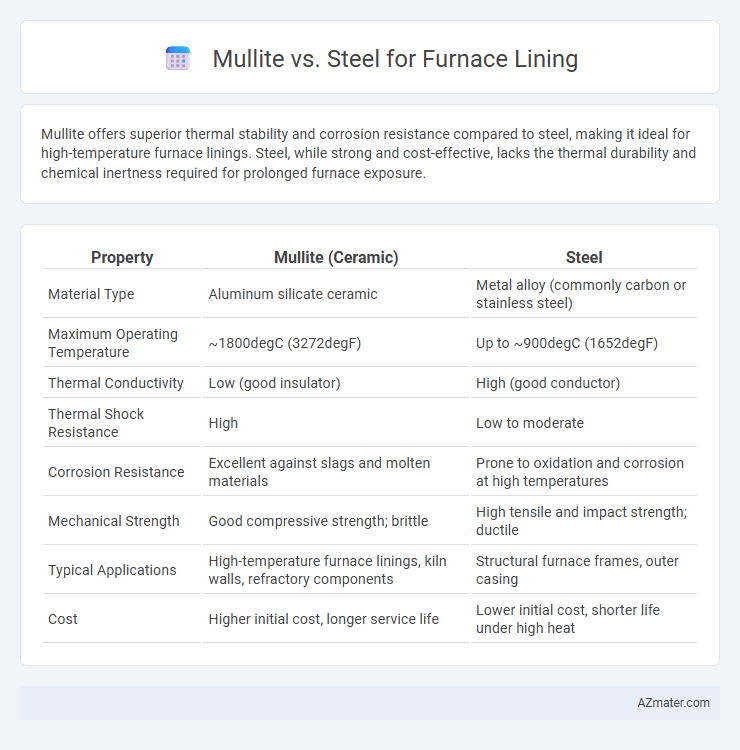Mullite offers superior thermal stability and corrosion resistance compared to steel, making it ideal for high-temperature furnace linings. Steel, while strong and cost-effective, lacks the thermal durability and chemical inertness required for prolonged furnace exposure.
Table of Comparison
| Property | Mullite (Ceramic) | Steel |
|---|---|---|
| Material Type | Aluminum silicate ceramic | Metal alloy (commonly carbon or stainless steel) |
| Maximum Operating Temperature | ~1800degC (3272degF) | Up to ~900degC (1652degF) |
| Thermal Conductivity | Low (good insulator) | High (good conductor) |
| Thermal Shock Resistance | High | Low to moderate |
| Corrosion Resistance | Excellent against slags and molten materials | Prone to oxidation and corrosion at high temperatures |
| Mechanical Strength | Good compressive strength; brittle | High tensile and impact strength; ductile |
| Typical Applications | High-temperature furnace linings, kiln walls, refractory components | Structural furnace frames, outer casing |
| Cost | Higher initial cost, longer service life | Lower initial cost, shorter life under high heat |
Introduction to Furnace Lining Materials
Furnace lining materials such as mullite and steel serve critical roles in high-temperature applications by providing thermal insulation and structural integrity. Mullite, a refractory ceramic, offers excellent thermal stability, high melting point around 1840degC, and resistance to thermal shock, making it ideal for lining furnaces exposed to extreme heat. Steel, while offering superior mechanical strength and durability, has lower heat resistance and often requires protective coatings to withstand prolonged exposure to high temperatures in furnace environments.
Overview of Mullite Properties
Mullite is a highly refractory ceramic material characterized by excellent thermal stability, low thermal conductivity, and superior resistance to thermal shock, making it ideal for furnace lining applications. Its chemical composition primarily includes alumina and silica, providing exceptional corrosion resistance against slags and molten metals commonly encountered in high-temperature environments. Compared to steel, mullite offers enhanced durability at temperatures exceeding 1400degC, reducing maintenance costs and prolonging furnace lifespan.
Overview of Steel Properties
Steel used in furnace linings offers high tensile strength, excellent thermal conductivity, and good resistance to thermal shock, making it suitable for structural support in high-temperature environments. Its durability under cyclic temperature changes enables extended service life in industrial furnaces, while also providing flexibility for fabrication and installation. However, steel's susceptibility to oxidation at elevated temperatures requires protective coatings or alloying elements to enhance corrosion resistance.
Thermal Resistance: Mullite vs Steel
Mullite offers superior thermal resistance compared to steel, with a melting point around 1840degC, making it ideal for furnace linings exposed to extreme temperatures. Steel melts at approximately 1370degC and is prone to oxidation and deformation under high heat, reducing its lifespan in furnace applications. The thermal stability of mullite ensures better insulation and longevity, minimizing heat loss and structural damage in high-temperature industrial environments.
Mechanical Strength Comparison
Mullite, characterized by its high-temperature resistance and excellent thermal stability, offers superior mechanical strength under extreme heat compared to steel, which tends to weaken and deform at elevated temperatures above 600degC. The intrinsic ceramic structure of mullite provides enhanced compressive strength and spalling resistance, making it ideal for furnace lining in high-temperature environments. Steel, although possessing high tensile strength at ambient conditions, suffers from reduced mechanical integrity and thermal expansion issues when exposed to prolonged furnace conditions, resulting in potential lining failure.
Chemical Stability in High-Temperature Environments
Mullite exhibits superior chemical stability in high-temperature furnace linings due to its excellent resistance to thermal shock and corrosion from molten slags and gases, maintaining structural integrity above 1600degC. Steel, although durable at moderate temperatures, suffers from oxidation and scaling in extreme heat, leading to rapid degradation and compromised furnace performance. Choosing mullite over steel ensures longer lifespan and reduced maintenance costs in chemically aggressive, high-temperature environments.
Lifespan and Durability
Mullite offers superior thermal stability and corrosion resistance, resulting in a longer lifespan compared to steel when used for furnace linings in high-temperature environments. Steel linings, while strong, are prone to oxidation and wear under extreme heat, reducing their durability and requiring more frequent maintenance. The enhanced durability of mullite reduces downtime and replacement costs, making it a preferred choice for industrial furnaces operating above 1500degC.
Cost-Effectiveness Analysis
Mullite offers superior thermal stability and resistance to chemical corrosion compared to steel, resulting in lower maintenance and longer service life for furnace linings. While steel has a lower initial cost, the frequent replacement and higher energy consumption due to poorer insulation properties make it less cost-effective over time. The overall cost-effectiveness analysis favors mullite for industrial furnaces, particularly in high-temperature environments requiring durability and energy efficiency.
Typical Applications and Industry Preferences
Mullite is extensively used for furnace linings in high-temperature applications such as glass manufacturing, ceramics, and refractories due to its excellent thermal stability and resistance to slag corrosion. Steel furnace linings are preferred in industries like steelmaking and petrochemical plants for their superior mechanical strength and ability to withstand thermal shock and abrasion. Industry preferences favor mullite in environments requiring high thermal insulation and chemical inertness, while steel linings are selected for structural durability and mechanical resilience.
Conclusion: Choosing the Optimal Furnace Lining Material
Mullite offers superior thermal stability and corrosion resistance, making it ideal for high-temperature furnace linings subjected to intense thermal cycling. Steel, while providing excellent mechanical strength and ease of fabrication, may suffer from oxidation and reduced lifespan in extreme heat conditions. Selecting mullite over steel optimizes furnace efficiency and durability, particularly in environments requiring sustained high temperatures and chemical inertness.

Infographic: Mullite vs Steel for Furnace lining
 azmater.com
azmater.com